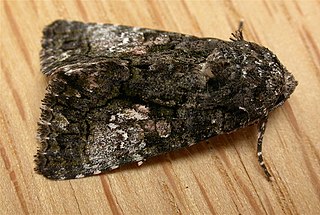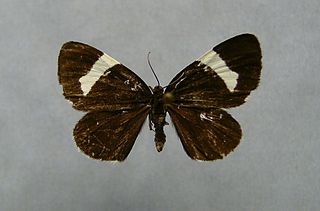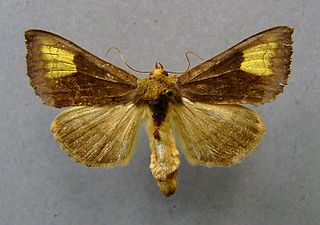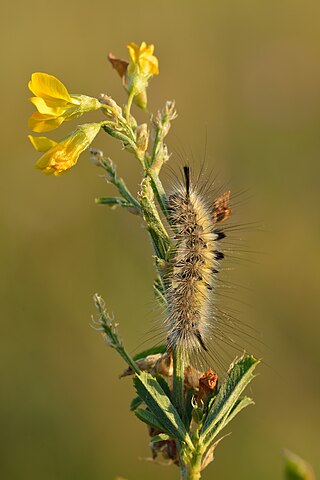A druid was a member of the learned class in ancient Celtic cultures. Some were priests, but the title was also used for doctors, law-speakers, and other high-ranking professionals.

Zygaena carniolica, sometimes described as the crepuscular burnet or eastern burnet, is a member of the family Zygaenidae.

Aedia is a genus of noctuid moths erected by Jacob Hübner in 1823. If it is placed in Catocalinae, it is assigned to its own subtribe, Aediina and if placed in Acontiinae, it is assigned to its own tribe Aediini.

Katha depressa, the buff footman, is a moth of the family Erebidae found in Asia and Europe. It was first described by Eugenius Johann Christoph Esper in 1787.

Hyles livornica, the striped hawk-moth, is a moth of the family Sphingidae.

Sabra harpagula, the scarce hook-tip, is a moth of the family Drepanidae first described by Eugenius Johann Christoph Esper in 1786. It is found from Europe through temperate Asia to Japan.

Aedia leucomelas, the eastern alchymist, sweet potato leaf worm or sorcerer, is a moth of the family Noctuidae. It is found in large parts of the world, ranging from Europe all over Asia up to Japan and some African countries. The subspecies Aedia leucomelas acronyctoides is found in Australia.

Calliergis is a genus of moths of the family Noctuidae. The genus was erected by Jacob Hübner in 1821.
Lipatephia is a monotypic moth genus of the family Erebidae erected by George Hampson in 1926. Its only species, Lipatephia illegitima, was first described by Wallengren in 1875. It is found in South Africa.

Cymbalophora pudica, the discrete chaperon, is a moth of the family Erebidae. The species was first described by Eugenius Johann Christoph Esper in 1784.

Baptria is a monotypic moth genus in the family Geometridae erected by Jacob Hübner in 1825. Its only species, Baptria tibiale, was first described by Eugenius Johann Christoph Esper in 1791. It is found in central and northern Europe.

Setina aurita is a moth of the family Erebidae. It was first described by Eugenius Johann Christoph Esper in 1787.

Diachrysia chryson, the scarce burnished brass, is a moth of the family Noctuidae. The species was first described by Eugen Johann Christoph Esper in 1789. It is found in central and southern Europe, Asia Minor across the Palearctic to Japan.

Gluphisia crenata, the dusky marbled brown, is a moth of the family Notodontidae. The species was first described by Eugenius Johann Christoph Esper in 1785. It is found in Europe, east over parts of Russia and China up to Japan. It is also found in North America, where it was traditionally treated as a separate species, Gluphisia septentrionis.

Calliergis ramosa is a moth of the family Noctuidae first described by Eugenius Johann Christoph Esper in 1786. It is found in central and southern Europe, from France north to the Netherlands, east to Poland, south through eastern Europe to Greece.

Glacies coracina, the black mountain moth, is a moth of the family Geometridae. The species was first described by Eugenius Johann Christoph Esper in 1805. It is found in northern Europe and in mountainous areas from Norway, Sweden, Finland, Poland and northern Russia to Japan. It is also present in Great Britain, Romania and Bulgaria and in the Alps. It is found at elevations of up to 3,000 meters.

Aedia perdicipennis is a moth of the family Noctuidae first described by Frederic Moore in 1882. It is found in the north-eastern Himalayas of India, Nepal, Thailand, Myanmar, Taiwan, Singapore, Borneo, Sumatra and Sulawesi.

Gynaephora selenitica is a moth in the family Erebidae first described by Eugenius Johann Christoph Esper in 1789. It is found from central Europe through eastern Europe to the Urals and Ob' River in West Siberia. It is not found in western and southern Europe and Scandinavia.
Aedia arctipennis is a species of moth of the family Noctuidae. It is found in Indonesia and Australia, where it has been recorded from Western Australia, the Northern Territory and Queensland.















